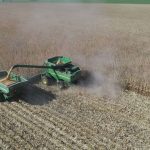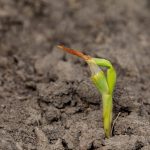Mastering weed control: power of sweeps in tillage farming
Sweeps – or shovels and plows as they’re known in some parts of the US – are an important tillage tool, used at various points throughout the farming year to aerate and condition the soil.
A sweep is a v-shaped or curved wing metal blade, typically designed to attach to the shanks of a row crop, or field cultivator or chisel plow. The sweep penetrates the soil to a fixed depth, and then as it is pulled through the soil it lifts and turns over the top layer.
The primary purpose of agricultural sweeps in tillage farming is to disturb the top layer of soil, break up any compacted soil, and incorporate crop residue or cover crops into the soil. This process helps to improve soil aeration, water infiltration, and nutrient availability, which are essential for healthy plant growth.
But there’s another important use for sweeps, and that’s weed control. With planting season now well underway, it won’t be long until farmers have to start thinking about suppressing weeds to ensure their crops receive optimal levels of light, nutrients and water.

How can sweeps be used to control weeds?
Controlling weeds with sweeps is referred to as mechanical weed control. It can be done prior to planting, or during the growing season. Some farmers will do both in order to give their crops the best chance of successful germination and growth.
Mechanical weed control is suitable for organic systems, and if done meticulously, can negate the use of chemical herbicides. Farmers may also use mechanical weed control in conjunction with herbicides. Here are some of the ways sweeps can help farmers to control weeds in their crop fields:
Weed removal
Using sweeps can physically uproot or sever young weeds as they push up through the soil. The young plants will then wither and die before they have a chance to become established or set seed. Shallow sweeps are usually sufficient for this task because the plants are still tender with poorly developed root systems, so soil disturbance is minimal. Regularly using sweeps can help farmers keep on top of weeds without the need for any other treatments.
Incorporating cover crops
Planting a cover crop is one method farmers can use to prevent soil erosion and reduce weed problems. Cover crops may be planted in the season before the main crop (for example, winter wheat), or they can be planted a short time before the main crop is due to be planted. In the latter case, the most common crops are fast-growing legumes like clover, peas, soybeans and alfalfa. These plants accumulate biomass quickly, crowding out weeds. The cover crop is terminated right before planting of the main crop, and the residues are incorporated into the soil using sweeps. This process is sometimes called ‘green mulching’.
Disturbing weed roots
For more established weeds, sweeps are a great way to cut through their root systems beneath the soil, preventing the plant from absorbing water and nutrients so that they wither up and die. It’s important to use strong, sharp blades and set the sweeps to a sufficient depth where they can cut through tough tap roots effectively.
Enhancing herbicide application
In some cases, sweeps are used in conjunction with herbicide application. The sweeps disturb the soil, which allows herbicides to reach the weed roots more easily. Combining mechanical and chemical weed control can significantly reduce the farmer’s dependence on expensive herbicides.

What’s the best type of sweep for weed control?
Sweeps come in a variety of shapes and widths for different tillage applications. Some are very narrow and pointed, while others have a shallower angle for less aggressive cutting. Sweeps also come in different depths.
Sweep shape
The angle and crown of a sweep wings will determine how it moves through the soil. Narrower winged sweeps are subject to less soil resistance so they can move more quickly and easily, especially in row crop cultivation. These sweeps are suitable for shallower cutting. Sweeps with a steeper angle will be met with more soil resistance and may be used in very dry or rocky conditions, so they move more slowly and smoothly, but are only suitable for use at shallow to medium depths.
Sweep width
The width of a sweep determines how much ground it can cover in a single pass. Wider sweeps typically have a shallower angle, and vice versa.
Sweep depth
The depth of a sweep is determined by the length of the stem or mounting bracket. A longer bracket will allow the sweep to penetrate more deeply, as will increasing the downward pressure on the plow or cultivator itself. Some machines have adjustable shanks so that farmers can get variable depths.
Narrower sweeps are better for cutting through the roots of established weeds. Wider, shallower sweeps are better for removing young weeds, or incorporating cover crops.

What should I look for when choosing sweeps for my machinery?
The most important thing is to ensure the sweep you choose are compatible with your machinery brand. At Wearparts, we offer a range of sweeps to fit all common chisel plow, row crop, and cultivator brands, including FallowMaster.
The second thing to think about is the durability of the sweep versus the cost. Think about your soil type – is it dry and rocky, or heavy clay? Perhaps it’s loamy and easy to work. If you’re going to be working in difficult soil conditions, it’s worth investing more in heavy duty sweeps that can withstand the intense friction and loading that will occur as you pass through the field.
In these conditions, cheaper sweeps are usually a false economy – they wear much more often, so you have to replace them more frequently, and you lose valuable time while your machine is down for maintenance.

Hardfaced sweeps
At Wearparts, we use premium-grade materials like boron steel to manufacture our agricultural sweeps. This gives our sweeps a unique balance of strength and flexibility that increases wearlife and reduces the risk of breakage, while maximizing efficiency even in tough soil conditions.
We also offer custom hardfacing as an option on all sweeps. You can choose to have your sweeps hardfaced on the top or bottom plus the stem. CMT Hardfacing is a cold welding process that adds material to the ground-engaging portion of the blade, without superheating the base material. This stops the formation of weak spots that can lead to premature wear. Our own independent tests show that our hardfaced sweeps can deliver up to 30% longer wear life in the field.
To find out more about our range of sweeps for chisel plows, row crop and field cultivators, get in touch!




